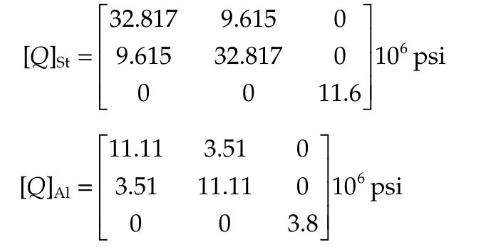The sensing element in many thermostats is a bimetallic strip (Figure 7.45), which is a nonsymmetric laminate
Question:
The sensing element in many thermostats is a bimetallic strip (Figure 7.45), which is a nonsymmetric laminate consisting of two plies made from different metals. If the strip is subjected to a temperature change \(\Delta T\), the differential thermal expansion of the two plies causes a corresponding change in the radius of curvature of the strip, \(ho_{x^{\prime}}\) and this motion activates the temperature control system. In the strip shown in Figure 7.45, ply \#1 is aluminum, ply \#2 is steel, both plies are isotropic, and each ply is \(0.005 \mathrm{in}\). thick. It has been determined that the effects of \(B_{i j}\)-type coupling on the thermal response of the strip can be neglected. Find the relationship between the temperature change \(\Delta T\) and the radius of curvature, \(ho_{x}\). Recall that the curvature \(\kappa_{x}=1 / ho_{x}\). The required properties are given below.
Ply thermal expansion coefficients:
Aluminum: \(\alpha_{\mathrm{Al}}=12.5 \times 10^{-6} /{ }^{\circ} \mathrm{F}\)
Steel: \(\alpha_{\mathrm{St}}=6.6 \times 10^{-6} /{ }^{\circ} \mathrm{F}\)
Laminate-bending compliances:

Ply stiffness matrices:


Step by Step Answer:

Principles Of Composite Material Mechanics
ISBN: 9781498720694
4th Edition
Authors: Ronald F. Gibson





